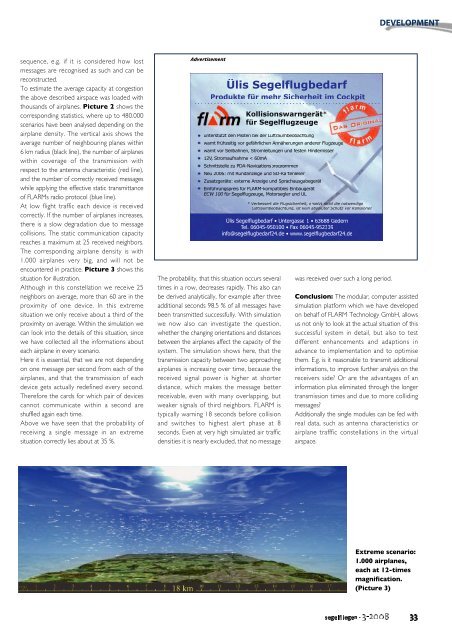Simulations for enhancing of the FLARM communication protocol
Simulations for enhancing of the FLARM communication protocol
Simulations for enhancing of the FLARM communication protocol
You also want an ePaper? Increase the reach of your titles
YUMPU automatically turns print PDFs into web optimized ePapers that Google loves.
sequence, e.g. if it is considered how lost<br />
messages are recognised as such and can be<br />
reconstructed.<br />
To estimate <strong>the</strong> average capacity at congestion<br />
<strong>the</strong> above described airspace was loaded with<br />
thousands <strong>of</strong> airplanes. Picture 2 shows <strong>the</strong><br />
corresponding statistics, where up to 480.000<br />
scenarios have been analysed depending on <strong>the</strong><br />
airplane density. The vertical axis shows <strong>the</strong><br />
average number <strong>of</strong> neighbouring planes within<br />
6 km radius (black line), <strong>the</strong> number <strong>of</strong> airplanes<br />
within coverage <strong>of</strong> <strong>the</strong> transmission with<br />
respect to <strong>the</strong> antenna characteristic (red line),<br />
and <strong>the</strong> number <strong>of</strong> correctly received messages<br />
while applying <strong>the</strong> effective static transmittance<br />
<strong>of</strong> <strong>FLARM</strong>s radio <strong>protocol</strong> (blue line).<br />
At low flight traffic each device is received<br />
correctly. If <strong>the</strong> number <strong>of</strong> airplanes increases,<br />
<strong>the</strong>re is a slow degradation due to message<br />
collisions. The static <strong>communication</strong> capacity<br />
reaches a maximum at 25 received neighbors.<br />
The corresponding airplane density is with<br />
1.000 airplanes very big, and will not be<br />
encountered in practice. Picture 3 shows this<br />
situation <strong>for</strong> illustration.<br />
Although in this constellation we receive 25<br />
neighbors on average, more than 60 are in <strong>the</strong><br />
proximity <strong>of</strong> one device. In this extreme<br />
situation we only receive about a third <strong>of</strong> <strong>the</strong><br />
proximity on average. Within <strong>the</strong> simulation we<br />
can look into <strong>the</strong> details <strong>of</strong> this situation, since<br />
we have collected all <strong>the</strong> in<strong>for</strong>mations about<br />
each airplane in every scenario.<br />
Here it is essential, that we are not depending<br />
on one message per second from each <strong>of</strong> <strong>the</strong><br />
airplanes, and that <strong>the</strong> transmission <strong>of</strong> each<br />
device gets actually redefined every second.<br />
There<strong>for</strong>e <strong>the</strong> cards <strong>for</strong> which pair <strong>of</strong> devices<br />
cannot communicate within a second are<br />
shuffled again each time.<br />
Above we have seen that <strong>the</strong> probability <strong>of</strong><br />
receiving a single message in an extreme<br />
situation correctly lies about at 35 %.<br />
Advertisement<br />
The probability, that this situation occurs several<br />
times in a row, decreases rapidly. This also can<br />
be derived analytically, <strong>for</strong> example after three<br />
additional seconds 98.5 % <strong>of</strong> all messages have<br />
been transmitted successfully. With simulation<br />
we now also can investigate <strong>the</strong> question,<br />
whe<strong>the</strong>r <strong>the</strong> changing orientations and distances<br />
between <strong>the</strong> airplanes affect <strong>the</strong> capacity <strong>of</strong> <strong>the</strong><br />
system. The simulation shows here, that <strong>the</strong><br />
transmission capacity between two approaching<br />
airplanes is increasing over time, because <strong>the</strong><br />
received signal power is higher at shorter<br />
distance, which makes <strong>the</strong> message better<br />
receivable, even with many overlapping, but<br />
weaker signals <strong>of</strong> third neighbors. <strong>FLARM</strong> is<br />
typically warning 18 seconds be<strong>for</strong>e collision<br />
and switches to highest alert phase at 8<br />
seconds. Even at very high simulated air traffic<br />
densities it is nearly excluded, that no message<br />
was received over such a long period.<br />
DEVELOPMENT<br />
Conclusion: The modular, computer assisted<br />
simulation plat<strong>for</strong>m which we have developed<br />
on behalf <strong>of</strong> <strong>FLARM</strong> Technology GmbH, allows<br />
us not only to look at <strong>the</strong> actual situation <strong>of</strong> this<br />
successful system in detail, but also to test<br />
different enhancements and adaptions in<br />
advance to implementation and to optimise<br />
<strong>the</strong>m. E.g. is it reasonable to transmit additional<br />
in<strong>for</strong>mations, to improve fur<strong>the</strong>r analysis on <strong>the</strong><br />
receivers side? Or are <strong>the</strong> advantages <strong>of</strong> an<br />
in<strong>for</strong>mation plus eliminated through <strong>the</strong> longer<br />
transmission times and due to more colliding<br />
messages?<br />
Additionally <strong>the</strong> single modules can be fed with<br />
real data, such as antenna characteristics or<br />
airplane trafffic constellations in <strong>the</strong> virtual<br />
airspace.<br />
Extreme scenario:<br />
1.000 airplanes,<br />
each at 12-times<br />
magnification.<br />
(Picture 3)


